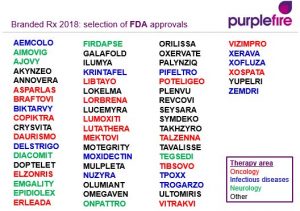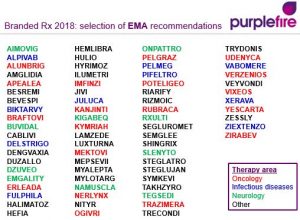Looking back
A strong reflection of the recent advances in cancer treatment approaches, oncological drugs led the way in both the US and Europe in terms of volume of new approvals/recommendations through the course of 2018, with infectious disease and neurological drugs accounting for the majority of NME (new molecular entity) launches in other therapy areas.
Pharmaceutical product naming in both regions is characterized by the broad array of different name types in use, ranging from the more identifiably suggestive to the outright arbitrary.

Name types
INN (or generic drug)-reflective brand names such as Emgality (galcanezumab), Galafold (migalastat), Xerava (eravacycline) and Talzenna (talazoparib) can usefully communicate drug origin and thereby suggest both function and indication.

Ingredient-referential names help underline special MOA features and differentiated treatments, such as Asparlas (calaspargase) or Epidiolex (epilepsy therapy, cannabidiol).
Less obvious names (without discernible meaning) that are more coined/invented can offer a sense of product uniqueness due to impactful or unusual look/sound/feel and act as “empty vessels” into which positive brand attributes may be imbued over time. Such examples include: Copiktra, Pifeltro, Tavalisse and Tegsedi.
Associative names may subtly embed patient or prescriber messaging such as aspired position (Erleada, “leading”), functional benefit (Motegrity, “motility”), formulation/benefit (Orilissa, “oral/release”) or indeed acronym references (Delstrigo, “single tablet regimen”, and Daurismo “SMO”/smoothened receptor inhibitor). Incorporating such cues enhances familiarity and also aids recall/recognition.
Image-driven names can be effective in also conjuring a sense of optimism or positivity in the minds of audiences, such as the sense of enlightenment or illumination evoked by Ilumetri, Luxturna, Ilumya, Lucemyra, Olumiant and Lumoxiti.
Intriguing and certainly noteworthy also are the handful of brand names in the Rx space that seem to defy convention and offer substantial stand-out by beginning with unusual double consonants, including Dzuveo, Tpoxx and Rxulti.
Looking forward
Cancer therapies will continue to dominate the new drug landscape over the coming months but innovative treatment launches in other areas are also expected.
Novartis’ gene therapy Zolgensma (encodes reference to spinal muscular atrophy) is set to gain approval in both US and European regions in early part of 2019 followed by Mayzent (implies “amazing” MS activity). Amongst many other, as-yet-unannounced, branded product launches, Lexicon’s Zynquista (sotagliflozin) for diabetes is also anticipated.
To contact Purple Fire Branding, specialists in brand naming, research and design, please telephone +44 (0)20 8166 1853 or visit www.purplefirebranding.com
